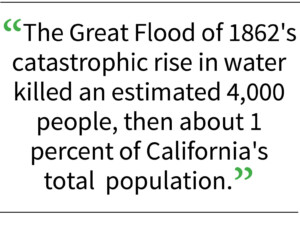Editorial: Storms can warn Californians about a ‘megaflood’
The Central Valley would experience flooding 300 miles long and at least 20 miles wide.
![]()

Curious people check out the major flooding at Miller’s Crossing in Gilroy’s Christmas Hill Park. Torrential rains have battered the South Valley region since late December.
Photo by Marty Cheek
This editorial is the opinion of Gilroy Life
The intense rainfall that recently pounded much of the state over several weeks should serve as a warning that California faces extremes in its weather patterns. We can go from extreme drought to extreme precipitation in a short time.
 Scientists warn we might some winter in the near future experience a series of atmospheric river storms coming from the Pacific Ocean resulting in a “megaflood” that could devastate most of the state.
Scientists warn we might some winter in the near future experience a series of atmospheric river storms coming from the Pacific Ocean resulting in a “megaflood” that could devastate most of the state.
A UCLA study published in Science Advances in August describes the scenario of what it called an ARkStorm that would produce deep and widespread flooding over a month-long series of tempests hitting California.
The report includes disaster outcomes including:
- The Central Valley would experience flooding 300 miles long and at least 20 miles wide.
- Serious flooding also would occur in Orange County, Los Angeles County, San Diego, the San Francisco Bay Area, and other coastal communities.
- Even with modern day reservoirs and levees, Stockton, Fresno and Los Angeles would be under water.
- Wind speeds in some places would reach 125 miles per hour.
- Hundreds of landslides would damage roads, highways, and homes.
- An increase in labor rates and other repair costs after the major natural disasters could increase property losses by 20 percent.
- Agricultural losses and other costs to repair lifelines, drain flooded islands, and repair damage from landslides would exceed $400 billion.
- Power, water, sewer, and other lifelines would experience damage that could take weeks or months to restore.
- Up to 1.5 million residents in the inland region and delta counties would need to evacuate due to flooding.
 Such a megaflood event happened about 120 years ago when 43 days of heavy rainstorms dumped the equivalent of 10 feet of water and snow on California. The Central Valley became an inland sea as the water filled the region from the Coast Range to the Sierra. The flooding drowned towns and cities, including the state capitol of Sacramento. It destroyed farmers’ crops and ranchers’ livestock. The Great Flood of 1862’s catastrophic rise in water killed an estimated 4,000 people, then about 1 percent of California’s total population. An equivalent death toll today would be 400,000 lives lost.
Such a megaflood event happened about 120 years ago when 43 days of heavy rainstorms dumped the equivalent of 10 feet of water and snow on California. The Central Valley became an inland sea as the water filled the region from the Coast Range to the Sierra. The flooding drowned towns and cities, including the state capitol of Sacramento. It destroyed farmers’ crops and ranchers’ livestock. The Great Flood of 1862’s catastrophic rise in water killed an estimated 4,000 people, then about 1 percent of California’s total population. An equivalent death toll today would be 400,000 lives lost.
Geologic evidence shows massive floods caused by atmospheric rivers of equal or greater magnitude to the 1861–1862 event have occurred in California about every 100 to 200 years. The ARkStorm report also found climate change has already made the extreme precipitation scenario twice as likely as more than a century ago, part of a trend projected to continue through 2100.
The report also states 21st century flooding devastation from an ARkStorm the equivalent of the Great Flood of 1862 might exceed $1 trillion, larger than any weather event in history. That’s three times what scientists calculate the amount of damage would be if Southern California were hit by “The Big One” earthquake. Compare an ARkStorm’s cost to the total combined dollars in damage of $656 billion from the five most costly hurricanes to hit the U.S. (Katrina, Harvey, Ian, Maria and Sandy).
A megaflood would potentially wreck the economy of California, the world’s fourth largest economy if it were an independent nation. The financial ripple effect from the devastation would spread across the United States if the state’s industry and agriculture cannot survive the aftermath of a megaflood. Because California companies are interconnected with international businesses, the catastrophe might cause a global depression that would impact the lives of billions of people.
In a press release, David Swain, a scientist on the UCLA report, emphasized that while the recent storms did not replicate an ARkStorm scenario, they showed the public how precipitation events are becoming even more extreme due to climate change.
 “Events like this that are potentially significant flood events, but aren’t on the level of the worst case scenario we explore in ARkStorm, hopefully are a wakeup call,” he said. “It’s a reminder California is a place that can see a lot of water really quickly and that potential is rising due to a warming climate.”
“Events like this that are potentially significant flood events, but aren’t on the level of the worst case scenario we explore in ARkStorm, hopefully are a wakeup call,” he said. “It’s a reminder California is a place that can see a lot of water really quickly and that potential is rising due to a warming climate.”
Californians focus their concerns on drought, earthquakes and wildfires. The major flooding across the state can serve as a cautionary reminder to include a megaflood on that list. We should encourage our political leaders on local, state and national levels to implement policy that will enable us to survive such a natural catastrophe.
- Editorial: County celebrates a century of natural wonders - May 11, 2024
- Editorial: County must balance equity, fairness in public contracts - May 3, 2024
- Editorial: Valley Water takes action against director’s misconduct - April 17, 2024

